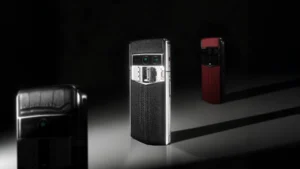Tired of missing the perfect shot because your phone's camera just can't keep up? Imagine capturing breathtaking landscapes or intimate portraits with the clarity and detail you've only dreamed of from a mobile device.
What You'll Learn:
- What truly defines a high-end phone for photography in 2025.
- The top smartphone cameras offering exceptional photographic capabilities this year.
- Key camera features that empower enthusiasts to elevate their mobile photography.
- Practical tips and tricks to maximize your smartphone photography skills.
Understanding What Makes a High-End Phone Great for Photography in 2025
In the competitive landscape of mobile technology, “high-end” for photography transcends mere brand name or price tag. It signifies a device engineered with the photographer in mind, prioritizing image quality, versatility, and user control.
Defining ‘High-End Phones' for the US Market
For the US market in 2025, a high-end phone geared towards photography typically boasts flagship processors, premium build materials, and, most importantly, a sophisticated camera system. These devices are often priced in the premium tier, reflecting their advanced technology and superior performance. They are designed to offer a near-DSLR experience in your pocket, capable of producing professional-looking stills and videos.
Key Camera Hardware: Beyond Megapixels
While megapixels still matter, they are no longer the sole determinant of image quality. Larger sensor sizes are crucial for better light gathering, leading to improved low-light performance and dynamic range. Advanced lens systems, including multiple focal lengths (wide, ultrawide, telephoto), are essential for creative flexibility. Features like optical image stabilization (OIS) are paramount for sharp shots, especially in challenging lighting or when shooting handheld.
“The sensor is the heart of the camera. A larger sensor captures more light, which directly translates to cleaner images with better detail, especially when the lights go down.” – Renowned Mobile Photography Expert
The Role of Computational Photography in 2025
Computational photography has revolutionized smartphone imaging. In 2025, it's more sophisticated than ever, utilizing AI and advanced algorithms to:
- Enhance dynamic range: Balancing bright skies and dark shadows seamlessly.
- Improve low-light performance: Reducing noise and preserving detail in dim conditions.
- Simulate bokeh: Creating professional-looking background blur for portraits.
- Offer advanced features: Like object recognition, scene optimization, and real-time adjustments.
This technology allows even smaller smartphone sensors to achieve remarkable results that were once only possible with dedicated cameras.
Top High-End Phone Cameras to Watch in 2025: A Comparative Look
The market is fiercely competitive, with several manufacturers pushing the boundaries of smartphone photography. Here's a look at the contenders you should have on your radar.
Apple's iPhone 16 Pro: Excellence in Video and Consistency
The iPhone has long been a favorite for its consistent image quality and exceptional video recording capabilities. The iPhone 16 Pro is expected to continue this legacy, offering:
- Improved low-light performance.
- Enhanced video features, potentially including higher frame rates and new cinematic modes.
- A user-friendly interface that appeals to both casual users and aspiring creators.
Its ProRes video format remains a significant draw for videographers seeking maximum flexibility in post-production.
Google Pixel 9 Pro: AI-Powered Magic and Low-Light Prowess
Google's Pixel line is renowned for its computational photography prowess, and the Pixel 9 Pro is no exception. Expect:
- Unmatched low-light performance thanks to Google's Night Sight technology.
- AI-driven editing features that can intelligently enhance photos.
- Magic Eraser and similar tools for effortless photo manipulation.
- A focus on natural-looking images with excellent color science.
Samsung Galaxy S25 Ultra: Versatility and Zoom Leadership
Samsung consistently aims for ultimate versatility, and the S25 Ultra is poised to deliver. Key strengths include:
- Industry-leading zoom capabilities, often featuring multiple telephoto lenses for impressive optical zoom ranges.
- High megapixel counts that offer incredible detail and cropping potential.
- A feature-rich camera app with extensive manual controls.
- Vibrant and punchy image processing, appealing to many users.
Here's a quick comparison of their camera highlights:
| Feature | iPhone 16 Pro | Google Pixel 9 Pro | Samsung Galaxy S25 Ultra |
| Primary Strength | Video recording, consistency | AI enhancements, low-light | Zoom versatility, detail |
| Low Light | Very good | Exceptional | Good |
| Zoom | Good optical zoom | Good optical zoom | Industry-leading optical zoom |
| Video Quality | Excellent (ProRes support) | Very good | Very good |
| AI Features | Smart HDR, Photographic Styles | Magic Eraser, Night Sight, AI Editing | Scene Optimizer, AI suggestions |
Essential Camera Features for Photography Enthusiasts
Moving beyond just the hardware, understanding and utilizing specific camera features can dramatically elevate your mobile photography.
Mastering Manual Controls: The Power of Pro Mode
Many high-end phones offer a “Pro Mode” or manual control option. This allows you to adjust settings like:
- ISO: Sensitivity to light.
- Shutter Speed: How long the shutter stays open.
- White Balance: Adjusting color temperature.
- Focus: Manually setting the focal point.
Learning to use these controls gives you creative freedom and the ability to overcome challenging lighting situations.
RAW vs. JPEG: Choosing the Right Format for Editing
- JPEG: Compressed, ready-to-share files. Offers smaller file sizes but with less editing flexibility.
- RAW: Unprocessed sensor data. Larger file sizes but provides the maximum amount of information for extensive editing in post-production, allowing for greater recovery of highlights and shadows.
For serious editing, shooting in RAW format is highly recommended.
Optical Zoom: Getting Closer Without Losing Quality
Optical zoom uses the phone's lenses to magnify the subject, preserving image quality. Digital zoom simply crops and enlarges the image, leading to a loss of detail. Phones with dedicated telephoto lenses offer superior optical zoom capabilities, essential for wildlife, sports, or distant subjects.
Understanding Aperture and Sensor Size
- Aperture: Measured in f-stops (e.g., f/1.8, f/2.4), a wider aperture (smaller f-number) allows more light to enter the sensor. This is crucial for low-light photography and achieving a shallower depth of field (background blur).
- Sensor Size: As mentioned, larger sensors capture more light and detail, leading to better image quality, especially in challenging conditions.
Maximizing Your Shots: Tips and Tricks for 2025 Smartphone Photography
Even with the best hardware, technique and understanding are key to capturing stunning images.
Leveraging AI Features for Stunning Results
Don't shy away from your phone's AI. Features like:
- Scene Optimizer: Automatically adjusts settings based on what you're shooting.
- AI Portrait Mode: Creates beautiful bokeh and subject separation.
- Night Mode: Transforms dark scenes into well-lit photographs.
Experiment with these to see how they can enhance your images with minimal effort.
Essential Mobile Editing Tools and Techniques
Post-processing is a vital part of digital photography. Popular mobile editing apps include:
- Adobe Lightroom Mobile: Powerful tools for color correction, exposure adjustments, and more.
- Snapseed: A free app with a wide range of professional editing features.
- VSCO: Known for its film-like presets and editing capabilities.
Key editing techniques:
- Adjusting exposure and contrast.
- Fine-tuning white balance and color saturation.
- Cropping and straightening for better composition.
- Sharpening to bring out details.
Troubleshooting Common Photography Issues
- Blurry photos: Ensure OIS is enabled, hold the phone steady, or use a tripod.
- Noisy images: Avoid high ISO in low light if possible, or use computational night modes.
- Poor dynamic range: Use HDR mode or shoot in RAW to recover details in highlights and shadows.
- Unwanted reflections: Try changing your angle or using a polarizing filter accessory.
Shooting Tips for Challenging Conditions
- Low Light: Utilize night mode, find light sources, and keep the phone as still as possible.
- Harsh Sunlight: Look for open shade, shoot during golden hours (sunrise/sunset), or use the HDR mode.
- Action Shots: Use burst mode to capture a sequence of images and select the best one.
- Portraits: Find good natural light, use portrait mode, and focus on the eyes.
FAQ (Frequently Asked Questions)
Q: Is a high megapixel count the most important factor for a phone camera?
A: No, while megapixels contribute to detail, sensor size, lens quality, and computational photography are equally, if not more, important for overall image quality, especially in low light and dynamic range.
Q: Can I get professional-looking photos with just my smartphone?
A: Absolutely. With a high-end smartphone camera, understanding of photography principles, and effective editing, you can achieve stunning, professional-quality results.
Q: What is the best way to improve my smartphone photography skills?
A: Practice regularly, study the features of your phone's camera app, experiment with manual controls, learn basic editing techniques, and seek inspiration from other photographers.
Q: Should I always shoot in RAW format?
A: If you plan to do significant editing, yes. RAW files offer the most flexibility. For quick sharing or if you're happy with the phone's processing, JPEG is perfectly fine.
Q: How does computational photography work?
A: It uses advanced software algorithms and AI to process image data from the sensor in ways that go beyond traditional photography. This allows for features like enhanced low-light performance, HDR, and simulated bokeh.








